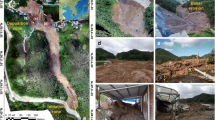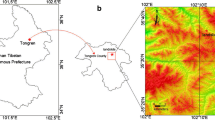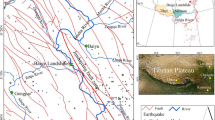Abstract
In Vietnam, landslides frequently occur on cut slopes along the road system during the rainy season. An understanding of the contributing factors and triggering mechanisms is essential so that effective measures can be taken to stabilize cut slopes and mitigate impacts caused by landslides. This study uses as a research subject the largest deep-seated landslide triggered by heavy rainfall on July 21, 2018, and the subsequent sliding induced by 5-day continuous rainfall events on the Halong–Vandon expressway. We examined the causative factors, failure mechanisms, and characteristics of the landslides through detailed geological investigation, unmanned aerial vehicle (UAV) surveys, and analysis of data from geology, geomorphology, well-prepared documents of rainfall events, and the expressway project. Results show that the heavy rainfall was the triggering factor for both events while slope cutting was the main landslide causative factor. The slump-type landslides occurred on weathered limestone layers that were parallel to the dip-slope direction of the strata. Geological settings of highly fractured and weathered sandstone, siltstone, and limestone combined with the development of karst caves favored the buildup of groundwater levels in deep layers, thereby causing deep-seated landslides. The analysis shows that in addition to geological factors, the landslide occurrences resulted from anthropogenic effects including the improper design of the calculation method for safety factors in road construction and quarrying activities. Site evidence and UAV photos also reveal that the July 21 landslide body on the lower slope was reactivated to travel downward due to the dynamic effect of the subsequent sliding on July 31. Based on numerical analysis using the Plaxis 2D model, an estimated sliding surface similar to the actual plane was simulated for the entire slope. Furthermore, the study presents an appropriate solution that has been applied to slope stabilization.













Similar content being viewed by others
References
Ashour M, Ardalan H (2010) Road embankment and slope stabilization. University transportation center for Alabama, report 09305
BC (2018) Project documents provided by the BOT Bien Cuong Joint Stock Company
Binh HT (2009) Landslide classification along Ho Chi Minh Route between Dakrong-Thachmy section and an appropriate proposal for coutermeasures. Proceeding of the Conference on Environmental Science and Technology 2019, Vietnam Institute of Transport Science and Technology, Hanoi, 30 October 2009, 7 pages (in Vietnamese).
Brinkgreve RBJ, Swolfs VM, Engin E (2010) Plaxis 2D 2010. Manual
DGM (1999) Geological Map of Ha Long city (F-48-xxx, Scale 1:200.000) published by the Department of Geology and Minerals of Vietnam
Duc DM (2013) Rainfall-triggered large landslides on 15 December 2005 in Van Canh district, Binh Dinh province, Vietnam. Landslides 10:219–230
Fawaz A, Farah E, Hagechehade F (2014) Slope stability analysis using numerical modelling. Am J Civ Eng 2(3):60–67
Frangov G, Zayakova H, Frangov S (2017) Destructive influence of technogenic factors and precipitations on landslide support structure. Advancing Culture of Living with Landslides, pp. 529–536. https://doi.org/10.1007/978-3-319-53487-9_62
Fukuoka H, Sassa K, Wang G, Sasaki R (2006) Observation of shear zone development in ring-shear apparatus with a transparent shear box. Landslides 3:239–251
Galuf S, Vojkan J (2017) Collapse and remediation of Vrhole landslide. Advancing Culture of Living with Landslides, pp 537–544. https://doi.org/10.1007/978-3-319-53487-9_62
Kang G-C, Song Y-S (2009) Kim T-H (2009) Behavior and stability of a large-scale cut slope considering reinforcement stages. Landslides 6:263–272
Katarina R, Goran G, Leo M, Marko K (2017) Advancing culture of living with landslides, pp. 569–576. https://doi.org/10.1007/978-3-319-53487-9_62
Liu C-N, Dong J-J, Chen C-J, Lee W-F (2012) Typical landslides and related mechanisms in Ali Mountain highway induced by typhoon Morakot: perspectives from engineering geology. Landslides 9:239–254
Lo C-M, Lee C-F, Chou H-T, Lin M-L (2014) Landslide at Su-Hua Highway 115.9k triggered by Typhoon Megi in Taiwan. Landslides 11:293–304
Loi DH, Quang LH, Sassa K, Takara K, Khang D, Thanh NK, Tien PV (2017) The 28 July 2015 rapid landslide at Ha Long city, Quang Ninh, Vietnam. Landslides 14:1207–1215
Luong LH, Miyagi T, Tien PV (2016) Mapping of large scale landslide topographic area by aerial photograph interpretation and possibilities for application to risk assessment for the Ho Chi Minh route – Vietnam. Transactions, Japanese Geomorphological Union, pp. 97–118
Ma S, Xu C, Shao X, Zhang P, Lian X, Tian Y (2019) Geometric and kinematic features of a landslide in Mabian Sichuan, China, derived from UAV photography. Landslides 16:373–381
Marco D, Elisabetta N, Paola S, Francesca A, Francesco B, Federica F, Michele S, Mauro C, Fausto G (2017) Impact of event landslides on road networks: a statistical analysis of two Italian case studies. Landslides 14(4):1521–1535
Miyagi T, Tien DV, Dung ND (2016) WG2 Landslide mapping and susceptibility evaluation along the Ho Chi Minh Route and Haivan Area. Proceeding of the Final SATREPS Workshop on Landslides, 13 October Hanoi, Vietnam, ISBN: 978-4-9903382-3-7, pp. 10-17
Morgenstern NR, Price VE (1965) The analysis of the stability of general slip surfaces. Geotechnique 15(1):79–93
Rawat S, Gupta AK (2016) Analysis of a nailed soil slope using limit equilibrium and finite element methods. Int J Geosynth Round Eng 2:34
Sassa K (1996) Prediction of earthquake induced landslides. Proceedings of 7th International Symposium on Landslides, AA Balkema, Trondheim, Vol. 1, pp 115–132
Sassa K, Nagai O, Solidum R, Yamazaki Y, Ohta H (2010) An integrated model simulating the initiation and motion of earthquake and rain induced rapid landslides and its application to the 2006 Leyte landslide. Landslides 7(3):219–236
Schweiger HF, Fabris C, Ausweger G, Hauser L (2018) Examples of successful numerical modelling of complex geotechnical problems. Innov Infrastruct Solut 4(1):2
Spencer E (1967) A method of analysis of the stability of embankments assuming parallel inter-slice forces. Geotechnique 17(1):11–26
Tam DM (2001) Flooding and landslides at the highways of Vietnam. Proceedings of the International Workshop on “Saving Our Water and Protecting Our Land”. Hanoi, 20-22 Oct. 2001. pp 18–27
Tam DM, Hanh NH, Hung NQ, Viet NB, Hung NV, Thao PT, Van Anh TT (2008) Selection and application conditions of the new technologies for landslide risk prevention along national highways. Research project in transportation sector, Ministry of Transport, 2008, 396 pages (in Vietnamese)
Tien Bui D, Tuan TA, Nhat HD, Thanh NQ, Duy NB, Liem NV, Pradhan B (2017) Spatial prediction of rainfall-induced landslides for the Lao Cai area (Vietnam) using a hybrid intelligent approach of least squares support vector machines inference model and artificial bee colony optimization. Landslides 14:447–458
Tien DV, Miyagi T, Abe S, Hamasaki E, Yoshimatsu H (2016a) Landslide susceptibility mapping along the HCMR in the Central of Vietnam - an application of an AHP approach to humid tropical area - Transactions, Japanese Geomorphological Union, vol 37–1
Tien PV, Sassa K, Takara K, Tam DM, Quang LH, Khang DQ, Luong LH, Loi DH (2016b) The influence of rainfalls on the potential of landslide occurrence on Hai Van Mountain in Vietnam. Proceeding of the Final SATREPS Workshop on Landslides, 13 October Hanoi, Vietnam, ISBN: 978-4-9903382-3-7, pp 112–121
Tien PV, Sassa K, Takara K, Fukuoka H, Khang D, Shibasaki T, Hendy S, Ha ND, Loi DH (2018) Formation process of two massive dams following rainfall-induced deep-seated rapid landslide failures in the Kii Peninsula of Japan. Landslides 15(9):1761–1778
Tien PV, Luong LH, Tuan LA (2019) Characteristics, causes and mechanisms of landslides along Halong-Vandon Expressway. Proceeding of the Annual Workshop on Science and Technology. Institute of Transport Science and Technology, 4 October 2019, Hanoi, Vietnam (13 pages).
W inter MG, Harrison M, Macgregor F, Shackman L (2013) Landslide hazard and risk assessment on the Scottish road network. Proceedings of the Institution of Civil Engineers - Geotechnical Engineering 166 (6):522–539
Winter MG, Shearer B, Palmer D, Peeling D, Harmer C, Sharpe J (2016) The economic impact of landslides and floods on the road network. Procedia Eng 143:1425–1434
Acknowledgements
Many thanks are due to Dr. Khang Dang (International Consortium on Landslides) and Dr. Le Hong Luong (Institute of Transport Science and Technology) for their valuable comments and support during this study.
Funding
This study is a part of the project for stabilizing the landslide slope on the Halong–Vandon Expressway invested by the BOT Bien Cuong Joint Stock Company. The authors appreciate the support from the BOT Bien Cuong Joint Stock Company, which provided various documents relevant to the project.
Author information
Authors and Affiliations
Corresponding author
Rights and permissions
About this article
Cite this article
Nguyen, L.C., Tien, P.V. & Do, TN. Deep-seated rainfall-induced landslides on a new expressway: a case study in Vietnam. Landslides 17, 395–407 (2020). https://doi.org/10.1007/s10346-019-01293-6
Received:
Accepted:
Published:
Issue Date:
DOI: https://doi.org/10.1007/s10346-019-01293-6




